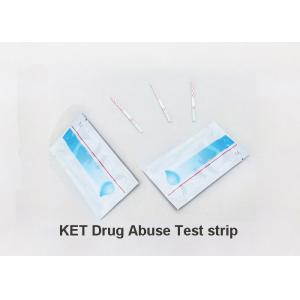
Add to Cart
KET (Ketamine ) Rapid Diagnostic Test Strip
Specimen: Urine
| Product | Cat No | Specimen | Sensitivity | Format | Kit Size |
| KET | YD161S3 | Urine | 1000 ng/mL | 3mm Strip | 100T |
| YD161C4 | 4mm Cassette | 25T |
Intended Use
The KET Rapid Test Strip (Urine) is a rapid chromatographic immunoassay for the detection of Ketamine in human urine at a cut-off concentration of 1,000ng/mL. This test will detect other related compounds, please refer to the Analytical Specificity table in this package insert. This assay provides only a preliminary analytical test result. A more specific alternate chemical method must be used in order to obtain a confirmed analytical result. Gas chromatography/mass spectrometry (GC/MS) is the preferred confirmatory method. Clinical consideration and professional judgment should be applied to any drug of abuse test result, particularly when preliminary positive results are used.
| Parameter | Calibrator | Cut-off (ng/mL) |
| KET (Ketamine ) | Ketamine | 1000 |
Test Principle
Ketamine is a dissociative anesthetic developed in 1963 to replace PCP (Phencyclidine). While Ketamine is still used in human anesthesia and veterinary medicine, it is becoming increasingly abused as a street drug. Ketamine is molecularly similar to PCP and thus creates similar effects including numbness, loss of coordination, sense of invulnerability, muscle rigidity, aggressive / violent behavior, slurred or blocked speech, exaggerated sense of strength, and a blank stare. There is depression of respiratory function but not of the central nervous system, and cardiovascular function is maintained. The effects of Ketamine generally last 4-6 hours following use. Ketamine is excreted in the urine as unchanged drug (2.3%) and metabolites (96.8%).1 The KET Rapid Test Dipstick (Urine) is a rapid urine screening test that can be performed without the use of an instrument. The test utilizes a monoclonal antibody to selectively detect elevated levels of Ketamine in urine. The KET Rapid Test Dipstick (Urine) yields a positive result when Ketamine in urine exceeds 1,000ng/mL.
DIRECTIONS FOR USE
INTERPRETATION OF RESULTS
NEGATIVE:* A colored line appears in the Control region (C) and colored lines appears in the Test region (T). This negative result means that the concentrations in the urine sample are below the designated cut-off levels for a particular drug tested.
*NOTE: The shade of the colored lines(s) in the Test region (T) may vary. The result should be considered negative whenever there is even a faint line.
POSITIVE: A colored line appears in the Control region (C) and NO line appears in the Test region (T). The positive result means that the drug concentration in the urine sample is greater than the designated cut-off for a specific drug.
INVALID: No line appears in the Control region (C). Insufficient specimen volume or incorrect procedural techniques are the most likely reasons for Control line failure. Read the directions again and repeat the test with a new test card. If the result is still invalid, contact your manufacturer.
LIMITATION
PERFORMANCE
Accuracy
A side-by-side comparison was conducted using The KET Rapid Test Dipstick and a commercially available KET rapid test. Testing was performed on 105 clinical specimens previously collected from subjects present for Drug Screen Testing. The following results were tabulated:
| Method | GC/MS | Total Results | |||
| KET Rapid | Results | Positive | Negative | ||
| Positive | 77 | 3 | 80 | ||
| Test Dipstick | |||||
| Negative | 2 | 168 | 170 | ||
| Total Results | 79 | 171 | 250 | ||
| % Agreement | 97.5% | 98.2% | 98.0% | ||
| ORIENT NEW LIFE MEDICAL CO., LTD. | |
| Contact: | Jerry Meng |
| Email: | Jerry @ newlifebiotest .com |
| Tel. | +86 18657312116 |
| SKYPE | enetjerry |